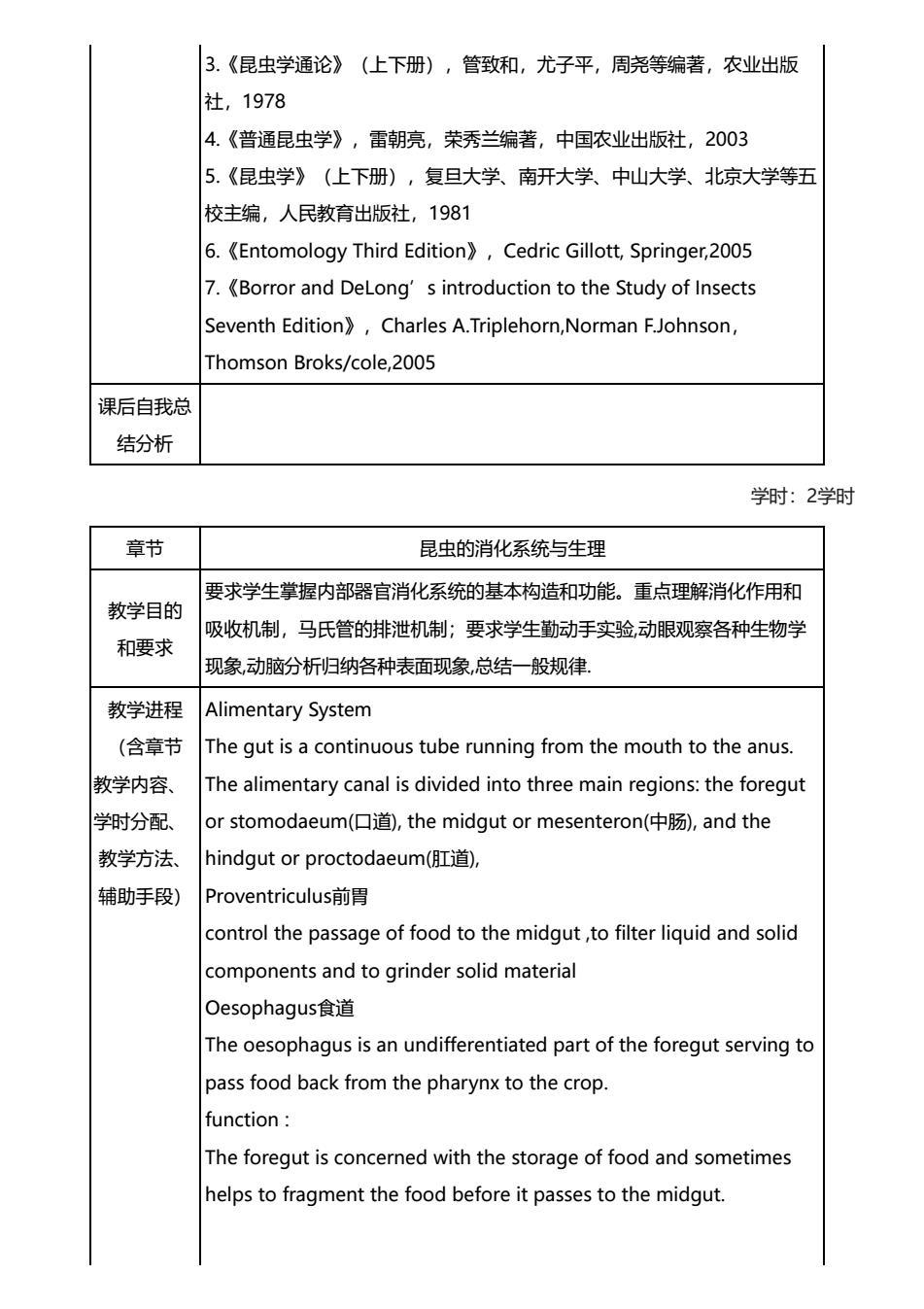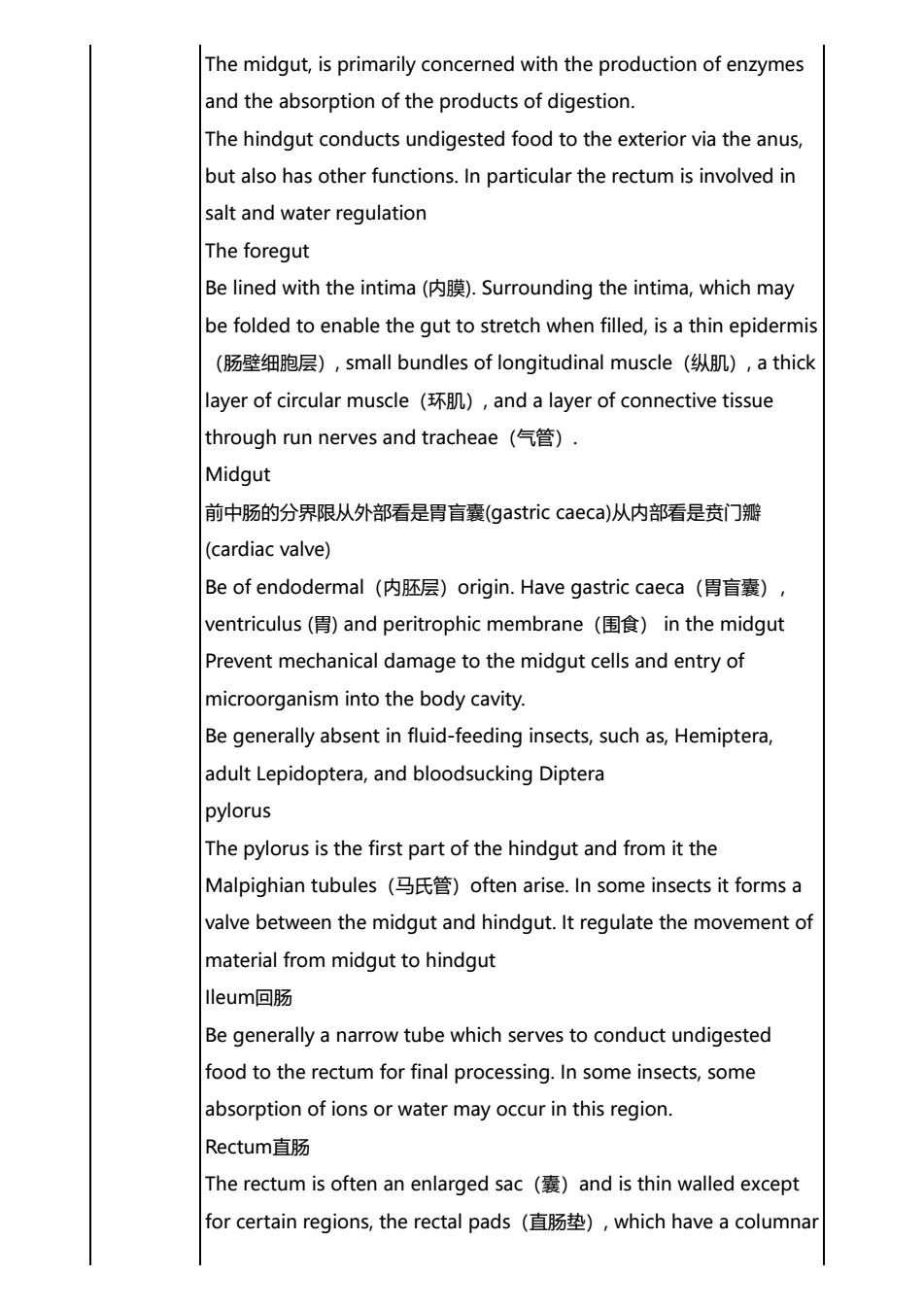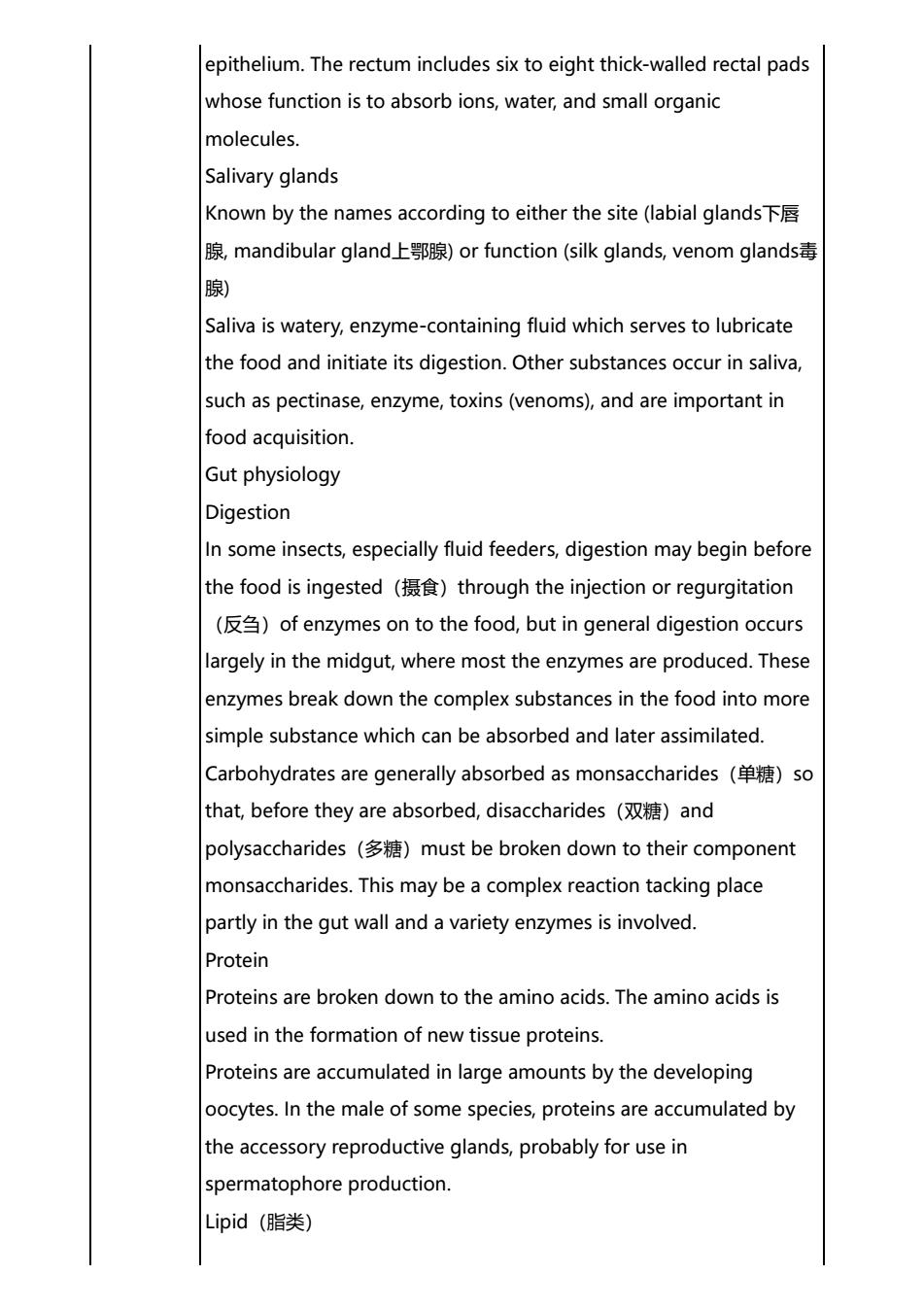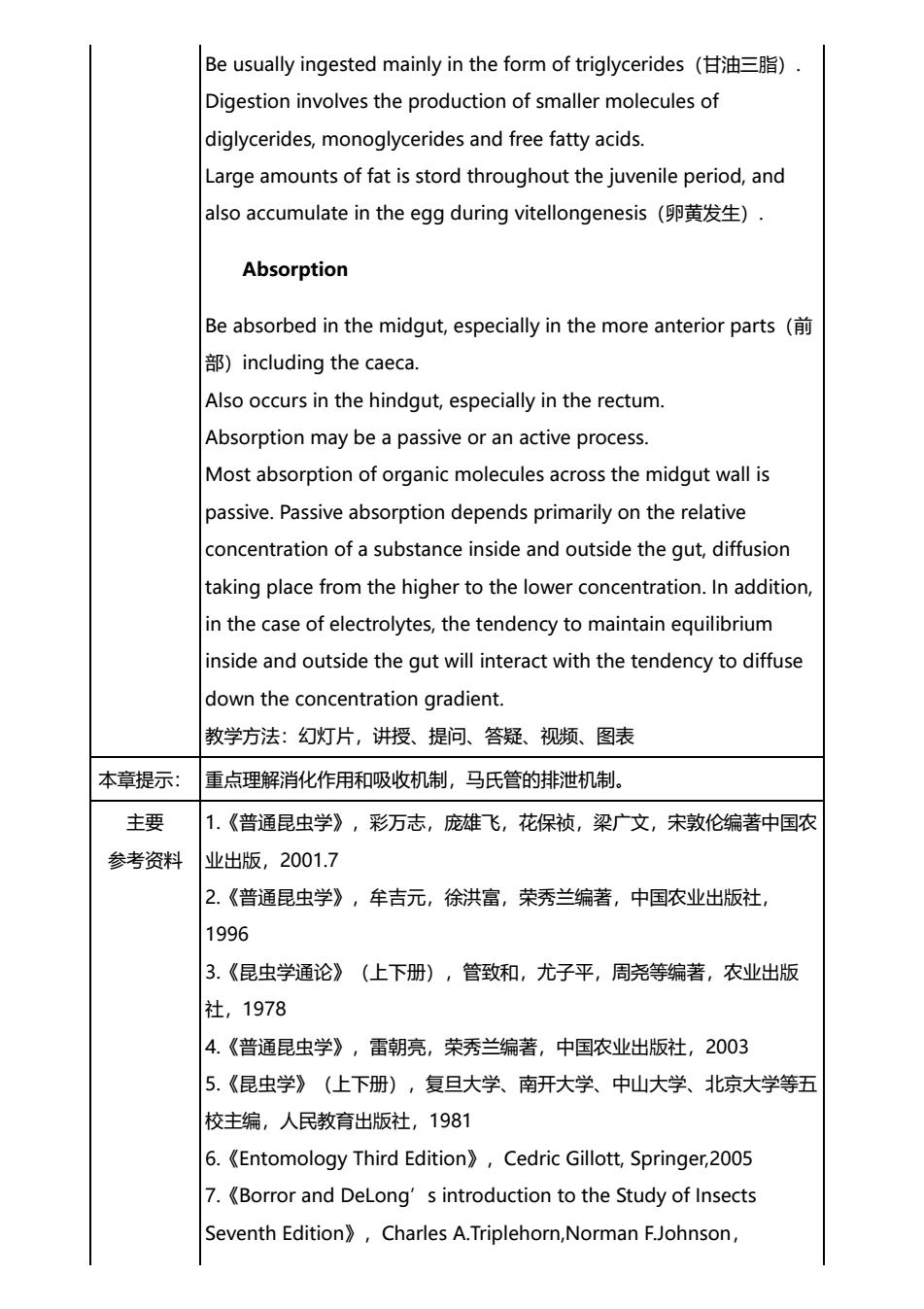
3.《昆虫学通论》(上下册),管致和,尤子平,周晓等编著,农业出版 社,1978 4.《普通昆虫学》,雷朝亮,荣秀兰编著,中国农业出版社,2003 5.《昆虫学》(上下册),复旦大学、南开大学、中山大学、北京大学等五 校主编,人民教育出版社,1981 6.Entomology Third Edition),Cedric Gillott,Springer,2005 7.Borror and DeLong's introduction to the Study of Insects Seventh Edition),Charles A.Triplehorn,Norman F.Johnson, Thomson Broks/cole,2005 课后自我总 结分析 学时:2学时 章节 昆虫的消化系统与生理 要求学生掌握内部器官消化系统的基本构造和功能。重点理解消化作用和 教学目的 吸收机制,马氏管的排泄机制;要求学生勤动手实验,动眼观察各种生物学 和要求 现象,动脑分析归纳各种表面现象,总结一般规律, 教学进程 Alimentary System (含章节 The gut is a continuous tube running from the mouth to the anus. 教学内容、 The alimentary canal is divided into three main regions:the foregut 学时分配、 or stomodaeum(▣道),the midgut or mesenteron(中肠),and the 教学方法、 hindgut or proctodaeum(肛道), 辅助手段) Proventriculus前胃 control the passage of food to the midgut,to filter liquid and solid components and to grinder solid material Oesophagus食道 The oesophagus is an undifferentiated part of the foregut serving to pass food back from the pharynx to the crop. function: The foregut is concerned with the storage of food and sometimes helps to fragment the food before it passes to the midgut
3.《昆虫学通论》(上下册),管致和,尤子平,周尧等编著,农业出版 社,1978 4.《普通昆虫学》,雷朝亮,荣秀兰编著,中国农业出版社,2003 5.《昆虫学》(上下册),复旦大学、南开大学、中山大学、北京大学等五 校主编,人民教育出版社,1981 6.《Entomology Third Edition》,Cedric Gillott, Springer,2005 7.《Borror and DeLong’s introduction to the Study of Insects Seventh Edition》,Charles A.Triplehorn,Norman F.Johnson, Thomson Broks/cole,2005 课后自我总 结分析 学时:2学时 章节 昆虫的消化系统与生理 教学目的 和要求 要求学生掌握内部器官消化系统的基本构造和功能。重点理解消化作用和 吸收机制,马氏管的排泄机制;要求学生勤动手实验,动眼观察各种生物学 现象,动脑分析归纳各种表面现象,总结一般规律. 教学进程 (含章节 教学内容、 学时分配、 教学方法、 辅助手段) Alimentary System The gut is a continuous tube running from the mouth to the anus. The alimentary canal is divided into three main regions: the foregut or stomodaeum(口道), the midgut or mesenteron(中肠), and the hindgut or proctodaeum(肛道), Proventriculus前胃 control the passage of food to the midgut ,to filter liquid and solid components and to grinder solid material Oesophagus食道 The oesophagus is an undifferentiated part of the foregut serving to pass food back from the pharynx to the crop. function : The foregut is concerned with the storage of food and sometimes helps to fragment the food before it passes to the midgut

The midgut,is primarily concerned with the production of enzymes and the absorption of the products of digestion. The hindgut conducts undigested food to the exterior via the anus, but also has other functions.In particular the rectum is involved in salt and water regulation The foregut Be lined with the intima().Surrounding the intima,which may be folded to enable the gut to stretch when filled,is a thin epidermis (肠壁细胞层),small bundles of longitudinal muscle(纵肌),a thick layer of circular muscle(环肌),and a layer of connective tissue through run nerves and tracheae(气管), Midgut 前中肠的分界限从外部看是胃盲囊(gastric caeca)从内部看是贲门 (cardiac valve) Be of endodermal(内胚层)origin.Have gastric caeca(胃盲囊), ventriculus(胃)and peritrophic membrane(围食)in the midgut Prevent mechanical damage to the midgut cells and entry of microorganism into the body cavity. Be generally absent in fluid-feeding insects,such as,Hemiptera, adult Lepidoptera,and bloodsucking Diptera pylorus The pylorus is the first part of the hindgut and from it the Malpighian tubules(马氏管)often arise..In some insects it forms a valve between the midgut and hindgut.It regulate the movement of material from midgut to hindgut leum回肠 Be generally a narrow tube which serves to conduct undigested food to the rectum for final processing.In some insects,some absorption of ions or water may occur in this region. Rectum直肠 The rectum is often an enlarged sac (and is thin walled except for certain regions,the rectal pads(直肠),which have a columnar
The midgut, is primarily concerned with the production of enzymes and the absorption of the products of digestion. The hindgut conducts undigested food to the exterior via the anus, but also has other functions. In particular the rectum is involved in salt and water regulation The foregut Be lined with the intima (内膜). Surrounding the intima, which may be folded to enable the gut to stretch when filled, is a thin epidermis (肠壁细胞层), small bundles of longitudinal muscle(纵肌), a thick layer of circular muscle(环肌), and a layer of connective tissue through run nerves and tracheae(气管). Midgut 前中肠的分界限从外部看是胃盲囊(gastric caeca)从内部看是贲门瓣 (cardiac valve) Be of endodermal(内胚层)origin. Have gastric caeca(胃盲囊), ventriculus (胃) and peritrophic membrane(围食) in the midgut Prevent mechanical damage to the midgut cells and entry of microorganism into the body cavity. Be generally absent in fluid-feeding insects, such as, Hemiptera, adult Lepidoptera, and bloodsucking Diptera pylorus The pylorus is the first part of the hindgut and from it the Malpighian tubules(马氏管)often arise. In some insects it forms a valve between the midgut and hindgut. It regulate the movement of material from midgut to hindgut Ileum回肠 Be generally a narrow tube which serves to conduct undigested food to the rectum for final processing. In some insects, some absorption of ions or water may occur in this region. Rectum直肠 The rectum is often an enlarged sac(囊)and is thin walled except for certain regions, the rectal pads(直肠垫), which have a columnar

epithelium.The rectum includes six to eight thick-walled rectal pads whose function is to absorb ions,water,and small organic molecules. Salivary glands Known by the names according to either the site(labial glands 腺,mandibular gland.上鄂腺)or function(silk glands,venom glands毒 腺) Saliva is watery,enzyme-containing fluid which serves to lubricate the food and initiate its digestion.Other substances occur in saliva, such as pectinase,enzyme,toxins(venoms),and are important in food acquisition. Gut physiology Digestion In some insects,especially fluid feeders,digestion may begin before the food is ingested (through the injection or regurgitation (of enzymes on to the food,but in general digestion occurs largely in the midgut,where most the enzymes are produced.These enzymes break down the complex substances in the food into more simple substance which can be absorbed and later assimilated. Carbohydrates are generally absorbed as monsaccharides so that,before they are absorbed,disaccharides (and polysaccharides must be broken down to their component monsaccharides.This may be a complex reaction tacking place partly in the gut wall and a variety enzymes is involved. Protein Proteins are broken down to the amino acids.The amino acids is used in the formation of new tissue proteins. Proteins are accumulated in large amounts by the developing oocytes.In the male of some species,proteins are accumulated by the accessory reproductive glands,probably for use in spermatophore production. Lipid(脂类)
epithelium. The rectum includes six to eight thick-walled rectal pads whose function is to absorb ions, water, and small organic molecules. Salivary glands Known by the names according to either the site (labial glands下唇 腺, mandibular gland上鄂腺) or function (silk glands, venom glands毒 腺) Saliva is watery, enzyme-containing fluid which serves to lubricate the food and initiate its digestion. Other substances occur in saliva, such as pectinase, enzyme, toxins (venoms), and are important in food acquisition. Gut physiology Digestion In some insects, especially fluid feeders, digestion may begin before the food is ingested(摄食)through the injection or regurgitation (反刍)of enzymes on to the food, but in general digestion occurs largely in the midgut, where most the enzymes are produced. These enzymes break down the complex substances in the food into more simple substance which can be absorbed and later assimilated. Carbohydrates are generally absorbed as monsaccharides(单糖)so that, before they are absorbed, disaccharides(双糖)and polysaccharides(多糖)must be broken down to their component monsaccharides. This may be a complex reaction tacking place partly in the gut wall and a variety enzymes is involved. Protein Proteins are broken down to the amino acids. The amino acids is used in the formation of new tissue proteins. Proteins are accumulated in large amounts by the developing oocytes. In the male of some species, proteins are accumulated by the accessory reproductive glands, probably for use in spermatophore production. Lipid(脂类)

Be usually ingested mainly in the form of triglycerides(甘油三脂) Digestion involves the production of smaller molecules of diglycerides,monoglycerides and free fatty acids. Large amounts of fat is stord throughout the juvenile period,and also accumulate in the egg during vitellongenesis(卵黄发生). Absorption Be absorbed in the midgut,especially in the more anterior parts including the caeca. Also occurs in the hindgut,especially in the rectum. Absorption may be a passive or an active process. Most absorption of organic molecules across the midgut wall is passive.Passive absorption depends primarily on the relative concentration of a substance inside and outside the gut,diffusion taking place from the higher to the lower concentration.In addition, in the case of electrolytes,the tendency to maintain equilibrium inside and outside the gut will interact with the tendency to diffuse down the concentration gradient. 教学方法:幻灯片,讲授、提问、答疑、视频、图表 本章提示: 重点理解消化作用和吸收机制,马氏管的排泄机制。 主要 1.《普通昆虫学》,彩万志,庞雄飞,花保祯,梁广文,宋敦伦编著中国农 参考资料 业出版,2001.7 2.《普通昆虫学》,牟吉元,徐洪富,荣秀兰编著,中国农业出版社, 1996 3.《昆虫学通论》(上下册),管致和,尤子平,周晓等编著,农业出版 社,1978 4.《普通昆虫学》,雷朝亮,荣秀兰编著,中国农业出版社,2003 5.《昆虫学》(上下册),复旦大学、南开大学、中山大学、北京大学等五 校主编,人民教育出版社,1981 6.Entomology Third Edition),Cedric Gillott,Springer,2005 7.Borror and DeLong's introduction to the Study of Insects Seventh Edition),Charles A.Triplehorn,Norman F.Johnson
Be usually ingested mainly in the form of triglycerides(甘油三脂). Digestion involves the production of smaller molecules of diglycerides, monoglycerides and free fatty acids. Large amounts of fat is stord throughout the juvenile period, and also accumulate in the egg during vitellongenesis(卵黄发生). Absorption Be absorbed in the midgut, especially in the more anterior parts(前 部)including the caeca. Also occurs in the hindgut, especially in the rectum. Absorption may be a passive or an active process. Most absorption of organic molecules across the midgut wall is passive. Passive absorption depends primarily on the relative concentration of a substance inside and outside the gut, diffusion taking place from the higher to the lower concentration. In addition, in the case of electrolytes, the tendency to maintain equilibrium inside and outside the gut will interact with the tendency to diffuse down the concentration gradient. 教学方法:幻灯片,讲授、提问、答疑、视频、图表 本章提示: 重点理解消化作用和吸收机制,马氏管的排泄机制。 主要 参考资料 1.《普通昆虫学》,彩万志,庞雄飞,花保祯,梁广文,宋敦伦编著中国农 业出版,2001.7 2.《普通昆虫学》,牟吉元,徐洪富,荣秀兰编著,中国农业出版社, 1996 3.《昆虫学通论》(上下册),管致和,尤子平,周尧等编著,农业出版 社,1978 4.《普通昆虫学》,雷朝亮,荣秀兰编著,中国农业出版社,2003 5.《昆虫学》(上下册),复旦大学、南开大学、中山大学、北京大学等五 校主编,人民教育出版社,1981 6.《Entomology Third Edition》,Cedric Gillott, Springer,2005 7.《Borror and DeLong’s introduction to the Study of Insects Seventh Edition》,Charles A.Triplehorn,Norman F.Johnson

Thomson Broks/cole,2005 课后自我总 结分析 学时:2学时 章节 昆虫的排泄生殖系统和生理 了解昆虫排泄器官的种类,马氏管的排泄机制和排泄过程,排泄系统的基 教学目的 本构造和功能;要求学生勤动手制作采集,动眼观察各种生物学现象,动脑分 和要求 析归纳各种表面现象,总结一般规律。 教学进程 第一节马氏管的构造和类型 (含章节 Structure and types of Malpighian Tubes 教学内容、 一、 马氏管 学时分配、 (一)马氏管的概念Concept of Malpighian Tubes 教学方法、 (二)马氏管的组织结构Organizing and Structure of Malpighian 辅助手段) Tubes(外一→内) (三)马氏管的类型ypes of Malpighian Tubes 1.直翅目型2.鞘翅目型3.半翅目型4.鳞翅目型 (四)马氏管的数目和表面积Number and Surface Proportion of Malpighian Tubes 第二节马氏管的排泄机制 Excretory MechanismofMalpighian Tubes 一、 排泄过程Excretory progress如吸血蝽 二、 排泄机制Excretory Mechanism (一)尿液酸化(二)液流循环(即排泄循环) (三)渗透作用 第三节马氏管的排泄物Excretion ofMalpighian Tubes 马氏管的排泄物主要是在新陈代谢过程中产生的含氨废物。 -、 排泄物的种类types of excretion (一)尿酸(二)尿囊酸(三)尿囊素(四)氨 二、马氏管的其它功能other function of Malpighian tubes 1.分泌泡沫和粘液2.分泌丝3.分泌石灰质 第四节昆虫的其它排泄器官The Other Excretory Organ of Insect 体壁(Body wall)
Thomson Broks/cole,2005 课后自我总 结分析 学时:2学时 章节 昆虫的排泄生殖系统和生理 教学目的 和要求 了解昆虫排泄器官的种类,马氏管的排泄机制和排泄过程,排泄系统的基 本构造和功能;要求学生勤动手制作采集,动眼观察各种生物学现象,动脑分 析归纳各种表面现象,总结一般规律。 教学进程 (含章节 教学内容、 学时分配、 教学方法、 辅助手段) 第一节 马氏管的构造和类型 Structure and types of Malpighian Tubes 一、马氏管 (一)马氏管的概念Concept of Malpighian Tubes (二)马氏管的组织结构Organizing and Structure of Malpighian Tubes (外→内) (三)马氏管的类型Types of Malpighian Tubes 1.直翅目型 2.鞘翅目型 3.半翅目型 4.鳞翅目型 (四)马氏管的数目和表面积Number and Surface Proportion of Malpighian Tubes 第二节 马氏管的排泄机制 Excretory MechanismofMalpighian Tubes 一、排泄过程Excretory progress 如吸血蝽 二、排泄机制Excretory Mechanism (一)尿液酸化 (二)液流循环(即排泄循环) (三)渗透作用 第三节 马氏管的排泄物Excretion ofMalpighian Tubes 马氏管的排泄物主要是在新陈代谢过程中产生的含氮废物。 一、排泄物的种类types of excretion (一)尿酸(二)尿囊酸 (三)尿囊素(四)氨 二、马氏管的其它功能other function of Malpighian tubes 1.分泌泡沫和粘液 2.分泌丝 3.分泌石灰质 第四节昆虫的其它排泄器官The Other Excretory Organ of Insect 一、体壁(Body wall)